CANATECH NITROGEN FIRE SUPPRESSION SYSTEM
Introduction
With the phase out of the most commonly used but environmentally damaging Halon 1301 and CO2 fire suppressant, nitrogen gases are becoming the global alternatives of choice in view of the following:
- Proven safety for people, property and the environment were natural requirements in addition to the desirable properties of effectiveness, cleanliness and zero secondary
- Nitrogen gases are the best choice for extinguishing agents as they extinguish fires by oxygen depletion by lowering the normal oxygen concentration in the air from 21% to about 12%, below the limit required for combustion whilst still provid- ing a safe and breathable
- The composition of a naturally occurring gas of nitrogen is a preferred choice as it provides users with all the advantag- es of an internationally accredited and environmentally friendly protection solution without the high costs of traditional implementation of
Description
The Natural Solution
Nitrogen is a gaseous clean fire suppressant comprised of 100% nitrogen which are naturally occruing gases. As nitrogen is derived from gases present in the atmosphere, it exhibits no ozone depleting potential, does not contribute to global warm- ing, nor does it contribute unique chemical species with extended atmospheric lifetimes. Because nitrogen is totally composed of atmospheric gases, it does not pose the prob- lems of toxicity associated with the chemically derived Halon alternatives.
Nitrogen fire suppression systems are developed to meet and exceed international standards.
Nitrogen System Application
Protecting life
Almost all fires are extinguished at the oxygen concentration level of below 15%. Nitrogen fire suppression systems reduces the oxygen concentration to around 12.5% to 10.5%, a level which is acceptable to human exposure over short periods of time.
One of the advantages of the nitrogen fire suppression agent is that it won’t produce a fog, so that occupants are not visibly impaired on the way to the exit. Furthermore, the nitrogen fire suppressant is not toxic, and more importantly, it will not break down into toxic or corrosive decomposition by products. Halocarbon alternative agents can create danger- ous levels of hydrogen fluoride when they contact with fire.
Protecting property
Nitrogen fire suppressant is ideally suited to protecting property. Upon deployment, nitrogen:
- Produces no condensation or temperature shocks that can cause harm to
- Produces no harmful or decomposition by products upon contact with heat or
- Produces no residue to clean up, is colourless, odourless and electrically non-conductive.
With virtually the same density as air, the nitrogen fire suppressant spreads quickly throughout the protected area and holds its concentration longer to snuff out fires in their early stages. Most other heavier than air Halon alter- natives sink to the floor and seep under doors and wells.
Nitrogen is also suitable for gas and liquid class B fires in addition to class A surface fires involving material such as wood, cloth and paper. However, it is not suitable for fires in substances that generates oxygen, like some reactive metals.
Protecting the environment
Nitrogen fire suppressant is completely environment friendly. It is composed entirely of naturally occurring gases which exists in the air we breathe.
In fact, the nitrogen gas presents no negative environ- mental impact which means…
- ZERO ozone depletion potential
- ZERO global warming potential
- ZERO atmospheric lifetime
When the nitrogen fire suppressant is used, its compo- nents is simply returned to the surrounding atmosphere. And because nitrogen is not a synthetic chemical, it is not subject to potential future use restriction. In fact, you would have to ban air in order to ban nitrogen.
Because nitrogen comprise of only Nitrogen, it achieves zero ODP and GWP unlike other halon replacement agents which are HFC based and are classified as Greenhouse gases in the same category as CO2 which contribute to Global warming.
It is with these considerations in mind that the use of CO2 is avoided in nitrogen thus avoiding possible limited product lifetime dictated by changes in global environ- ment legislation. Your nitrogen fire suppressant could be used forever as there will never be any environmental restrictions on the use of Nitrogen, which is the biggest element of air.
Nitrogen System Design and Operation
Canatech’s nitrogen systems are designed, installed and maintained according to NFPA 2001 (Clean Agent Fire Extinguishing Systems and ISO 14520 Gaseous Fire Extinguishing Systems) standards.
Nitrogen is a total flooding system where by the required amount of gas is discharged into an enclosed area to extinguish fire. The gas is stored as compressed gas at 50 bar or 170 bar. The system can be actuated electrically from a control panel or manually actuated from the cylin- der bank. The system is normally designed as such that 95% of the gas will be discharged into the protected area within 60 seconds.
Multiple storage options are possible with nitrogen as the system has been designed for long distance delivery. This means that the cylinder bank can be stored remotely from the risk area when storage space is a concern.
When two or more areas of protection do not require flooding of gas at the same time, directional or selector valves can be used to allow the same bank of cylinders to protect multiple areas. Such sub-systems can reduce substantial equipment costs and storage area for cylin- ders. Maintenance and inspection locations can also be reduced accordingly.
Hệ thống chữa cháy khí Nitrogen - CANATECH
| Danh mục | Tải File |
| CATALOGUE-NITROGEN-CANATECH |
Only logged in customers who have purchased this product may leave a review.

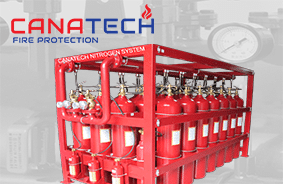
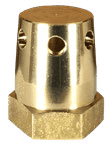

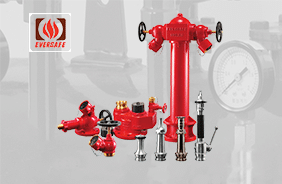

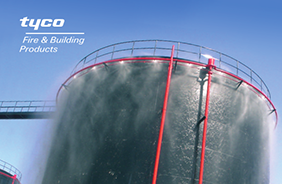
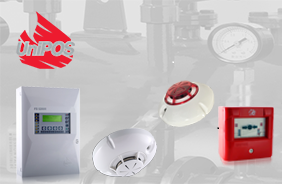
Reviews
There are no reviews yet.